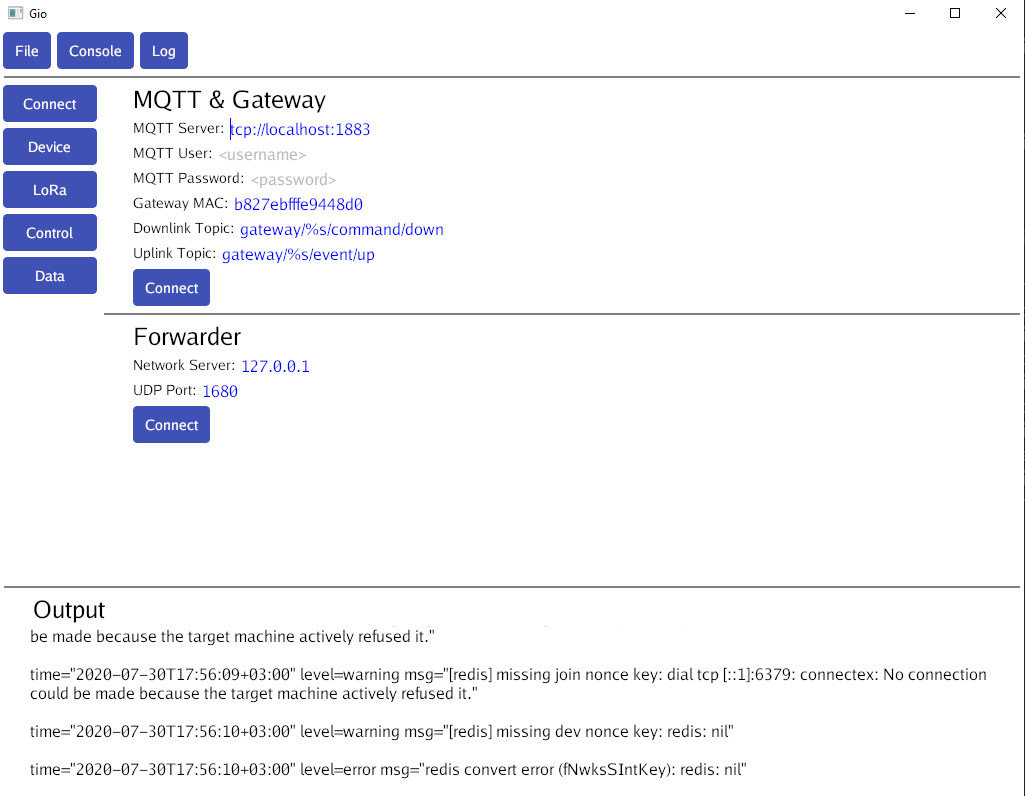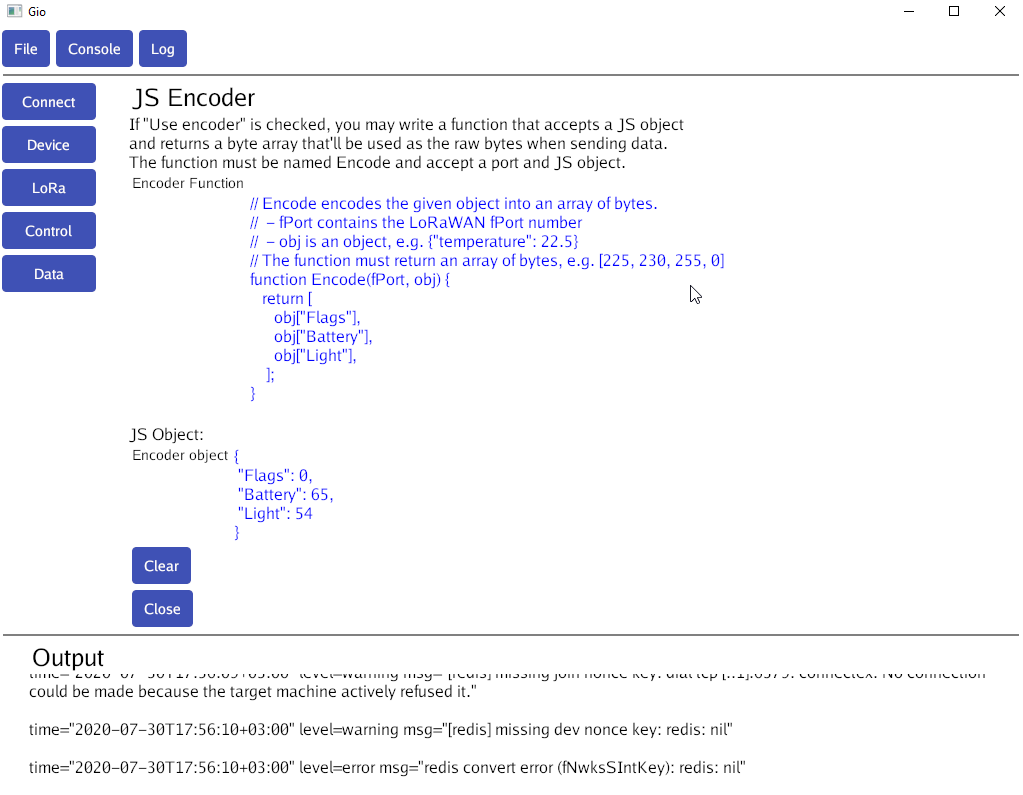This is an utility program to simulate LoRaWAN devices.
It supports all bands and configurations LoRaWAN versions 1.0 and 1.1 and is compatible with newest versions of ChirpStack Network Server modules (v3 test) and lorawan-server.
For the ChirpStack project, it acts, basically, as a chirpstack-gateway-bridge middleman, publishing and receiving messages through MQTT.
This program was also extended to generate raw PACKET FORWARDER UDP-based protocol as alternative transport, to be used with general LoRaWAN network server (e.g. lorawan-server). Use forwarder configuration section to enable.
It has a simple but complete GUI built with gioui, that allows to configure everything that's needed, such as network server address and port or MQTT broker and credentials, device keys, LoRaWAN version, message marshaling method, data payload, etc.
Please report any bug or request new features by filing an issue.
As mentioned, this program needs OpenGL 3.2 (for Linux) to be installed. Also, it uses Redis to store device addres and keys, frame counters and nonces in OTAA mode.
The GUI allows to modify all options, but they may also be seeded with a conf file for ease of use. An example file is provided to get an idea, but the program will only load a conf file with the name conf.toml located at the same dir as the binary, or if the path is given with the --conf flag:
#Configuration.
log_level = "info"
[provisioner]
hostname = "https://example.com"
username = "username"
password = "password"
path = "path/to/devices.csv"
[mqtt]
server = "tcp://localhost:1883"
user = "username"
password = "password"
# Uplink topic. %s will be replaced with the gateway mac.
uplink_topic="gateway/%s/event/up"
# Downlink topic. %s will be replaced with the gateway mac.
downlink_topic="gateway/%s/command/down"
[gateway]
mac = "b827ebfffe9448d0"
[band]
name = "AU_915_928"
[device]
eui="0000000000000000"
address="000f6e3b"
network_session_encription_key="dc5351f56794ed3ac17c382927192858"
serving_network_session_integrity_key="dc5351f56794ed3ac17c382927192858"
forwarding_network_session_integrity_key="dc5351f56794ed3ac17c382927192858"
application_session_key="7b14565ba0e30d6ced804393fd6a0dd5"
marshaler="json"
nwk_key="00000000000000010000000000000001"
app_key="00000000000000010000000000000001"
join_eui="0000000000000002"
mac_version=1
profile="OTAA"
joined=false
skip_fcnt_check=true
[data_rate]
bandwith = 125
spread_factor = 10
bit_rate = 0
[rx_info]
channel = 0
code_rate = "4/5"
crc_status = 1
frequency = 916800000
lora_snr = 7.0
rf_chain = 1
rssi = -57
[raw_payload]
payload = "ff00"
use_raw = false
script = "\n// Encode encodes the given object into an array of bytes.\n// - fPort contains the LoRaWAN fPort number\n// - obj is an object, e.g. {\"temperature\": 22.5}\n// The function must return an array of bytes, e.g. [225, 230, 255, 0]\nfunction Encode(fPort, obj) {\n\treturn [\n obj[\"Flags\"],\n obj[\"Battery\"],\n obj[\"Light\"],\n ];\n}\n"
use_encoder = true
max_exec_time = 500
js_object = "{\n \"Flags\": 0,\n \"Battery\": 65,\n \"Light\": 54\n}"
fport = 2
[[encoded_type]]
name = "Flags"
value = 5.0
max_value = 255.0
min_value = 0.0
is_float = false
num_bytes = 1
[[encoded_type]]
name = "Batería"
value = 80.0
max_value = 255.0
min_value = 0.0
is_float = false
num_bytes = 1
[[encoded_type]]
name = "Luz"
value = 50.0
max_value = 255.0
min_value = -0.0
is_float = false
num_bytes = 1
[redis]
addr = "localhost:6379"
password = ""
db = 10
[window]
width = 1200
height = 1000
[forwarder]
nserver = "192.168.5.71"
nsport = "1680"You may also import files located at working-dir/confs and save to the same directory.
When OTAA is set and the device is joined, upon initialization the program will try to load keys and relevant data from Redis, overriding keys from the file.
The data to be sent may be presented as a hex string representation of the raw bytes, using a JS object and a decoding function to extract a bytes array from it, or using our encoding method (which then needs to be decoded accordingly at lora-app-server). As a reference, this is how we encode our data:
func GenerateFloat(originalFloat, maxValue float32, numBytes int32) []byte {
byteArray := make([]byte, numBytes)
if numBytes == 4 {
encodedFloat := uint32((originalFloat / maxValue) * float32(math.Pow(2, 31)))
binary.BigEndian.PutUint32(byteArray, encodedFloat)
} else if numBytes == 3 {
encodedFloat := uint32((originalFloat / maxValue) * float32(math.Pow(2, 23)))
temp := make([]byte, 4)
binary.BigEndian.PutUint32(temp, encodedFloat)
byteArray = temp[1:]
} else if numBytes == 2 {
encodedFloat := uint16((originalFloat / maxValue) * float32(math.Pow(2, 15)))
binary.BigEndian.PutUint16(byteArray, encodedFloat)
} else if numBytes == 1 {
byteArray[0] = uint8(originalFloat)
}
return byteArray
}
func GenerateInt(originalInt, numBytes int32) []byte {
bRep := make([]byte, numBytes)
if numBytes == 4 {
binary.BigEndian.PutUint32(bRep, uint32(originalInt))
} else if numBytes == 3 {
temp := make([]byte, 4)
binary.BigEndian.PutUint32(temp, uint32(originalInt))
bRep = temp[1:]
} else if numBytes == 2 {
binary.BigEndian.PutUint16(bRep, uint16(originalInt))
} else if numBytes == 1 {
bRep[0] = uint8(originalInt)
}
return bRep
}When using our encoding method, values may be added using the Add encoded type button and setting the options.
To use your own custom JS encoder, click the "Use encoder" checkbox and the "Open decoder" button to open the form:
All lorawan package end-device MAC commands are available to be sent with a message. Check desired mac commands and fill their payloads when needed.
You may provision devices from a CSV file using the simple https://github.com/iegomez/lsp package. Open the form with File -> Provision, which'll let you input hostname, username and password (click Login to get and store a token for further calls), fill the local path to point to the desired CSV (click Load to retrieve devices from the file) and then click on Provision to provision the devices through lora-app-server's API. See https://github.com/iegomez/lsp/blob/master/devices-example-format.csv to check the required CSV format.
The package is written in Go and tested with Go 1.14, which can be downloaded from https://golang.org/dl/. The GUI is built using gioui Finally, the program depends on Redis.
Something like this should work for Debian / Ubuntu / Mint, but please check gioui and general OpenGL docs to see requirements for your system:
sudo apt-get install build-essential redis-server
sudo apt-get install xorg-dev libgl1 libgl1-mesa-dev libgl1-mesa-glx libgles2-mesa-dev
sudo apt-get install libxkbcommon-x11-0 libxkbcommon-x11-devOnce those are met, you may build the package like this, which will manage dependencies using Go modules:
makeThis will create the gui executable.
Build was tested under Windows 10, only Go 1.14 and GNU make are required to build the application:
makeThis will create the gui.exe executable.

